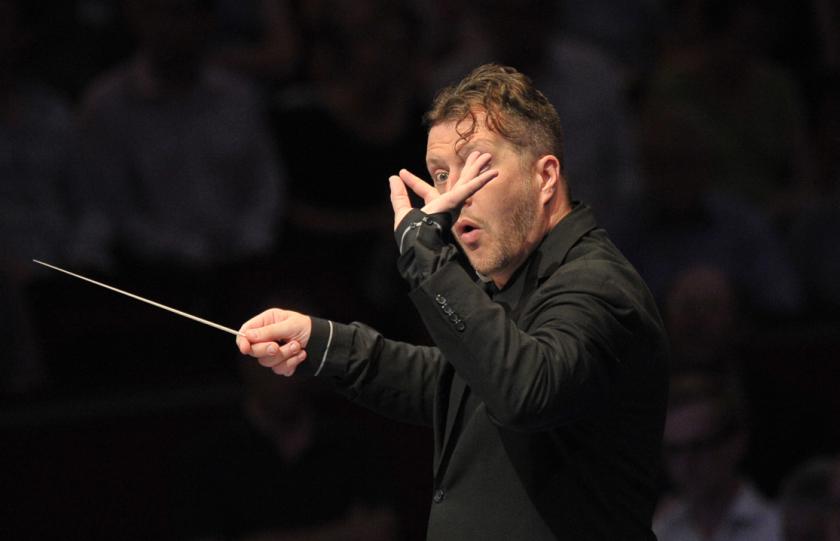Anniversary years are essential to classical music, shaking up our regular rhythms of programming and listening every year with new emphasis and new discoveries. While Britten, Wagner and Verdi have all had their moments in 2013, it is Witold Lutosławski who may yet emerge as the unlikely hero. Last night his exquisitely stark Cello Concerto held its own against a major Adès premiere, itself written in memory of the elder composer – surely one of the 20th century’s neglected greats.
The Cello Concerto isn’t folk-charming like the Concerto for Orchestra or sensuously appealing like the Third Symphony. You need to live with it, get a feel for its rather extraordinary architecture before it really makes sense. But dramatically it’s all there from the start. The dialogue Mstislav Rostropovich (the work’s dedicatee) perceived between an individual and an oppressive collective may have worried Lutosławski, muddying his characteristic abstraction, but provides a vivid way into this classic concerto.
The BBCSO once again yielded some beautifully balanced textures
Last night soloist Paul Watkins (pictured below) offered a beautifully introspective, ambiguous reading, never allowing himself the obvious choice of Shostakovich-like release. The result kept the tension almost painfully sustained through the four continuous movements, sustaining a thread of quiet protest between the provocative opening solo section and the explosive finale. Adès kept the BBC Symphony Orchestra on a tight leash, highlighting the textural details of the composer’s orchestration rather than the blunter battle between their forces and the cello. All eventually wound itself up into a Finale of vigorous conviction, giving a hint of the rhythmic energy to come in Adès’s own Totentanz.
 At over 30 minutes long Totentanz is symphonic in scope if not in structure or process. Based on a 15th century painting depicting Death and a sequence of his victims – A Pope, Cardinal, soldier, king etc – the piece establishes a dialogue between solo baritone (Death) and mezzo (his many victims). Each interaction consists of an invitation from Death to join him in his macabre dance, a reaction from the victim, and then an orchestral burst as each consummation is achieved. It’s a fragmented structure, and one that has to sustain momentum through the encounters if it isn’t to feel repetitious.
At over 30 minutes long Totentanz is symphonic in scope if not in structure or process. Based on a 15th century painting depicting Death and a sequence of his victims – A Pope, Cardinal, soldier, king etc – the piece establishes a dialogue between solo baritone (Death) and mezzo (his many victims). Each interaction consists of an invitation from Death to join him in his macabre dance, a reaction from the victim, and then an orchestral burst as each consummation is achieved. It’s a fragmented structure, and one that has to sustain momentum through the encounters if it isn’t to feel repetitious.
Directed by the composer himself, the BBCSO once again yielded some beautifully balanced textures, creating a coherent dramatic palette to unite the flimsiest of string hazes and the massive weight of an enormous Taiko drum. Percussion features large here, and Adès plays with pitched and unpitched sounds, creating a world at once tonally defined but not altogether tonal.
 It was only a matter of time before Adès, British music’s Lord of the Dance, wrote a Totentanz, and the result achieves all the macabre giddiness you might expect, liberally laced with fragments of the Dies Irae planchaint. Encounters start off straightforward enough with Emperor and Cardinal, but as patterns repeat and multiply the emotional weight builds (the Peasant’s section with its rhythmic sallies from the brass and lolloping, off-kilter percussion is a highlight), eventually climaxing in a moment of rhythmic rejection in the still beauty of the Parish Clerk’s music.
It was only a matter of time before Adès, British music’s Lord of the Dance, wrote a Totentanz, and the result achieves all the macabre giddiness you might expect, liberally laced with fragments of the Dies Irae planchaint. Encounters start off straightforward enough with Emperor and Cardinal, but as patterns repeat and multiply the emotional weight builds (the Peasant’s section with its rhythmic sallies from the brass and lolloping, off-kilter percussion is a highlight), eventually climaxing in a moment of rhythmic rejection in the still beauty of the Parish Clerk’s music.
This shock is nothing, however, compared to that of a quasi-Mahlerian finale. Death, so matter-of-fact with the officials, is drawn into something closer to a liebestod with the Maiden and finally the Child, with scatter-gun pitches suddenly coalescing into thick harmonies. It’s a coup de theatre that reverses expectations, not piercing onwards to the bone beneath the skin but retreating to the fleshy fantasy of human life. Simon Keenlyside’s Death was all bluff charisma, luring his victims with lazy charm and absolute vocal ease. He was almost outdone however by Christianne Stotijn (pictured left), whose still-growing range of vocal colours and power created a constantly metamorphosing play of sound and character. Totentanz is a major work, and one that has a natural place in the repertoire alongside the big orchestral song cycles and symphonies of the late German Romantics. Surely this will be one Proms premiere with a real afterlife.















Add comment